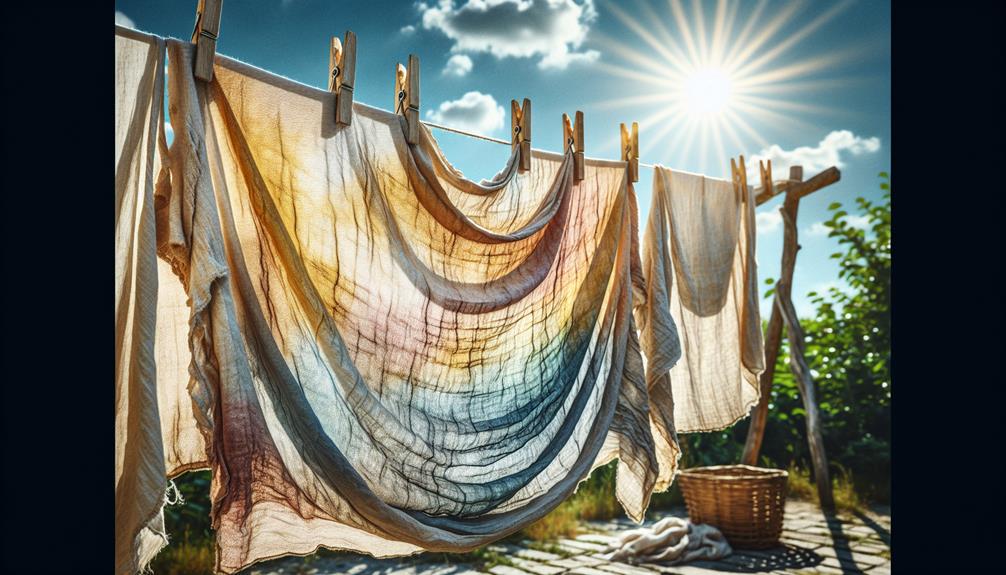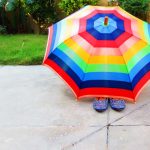Yes, linen offers sun protection influenced by thickness, dye, weaving, and color. Dark hues like indigo enhance UV defense. It compares to cotton's sun safety. Linen's UPF ranges from 5 to 25, with dark shades potentially offering more security. Factors like fabric characteristics and color play a crucial role in its sun protection properties. Dark-colored linen can absorb UV radiation better. Understanding these aspects can help improve linen's sun resistance. Find out more about linen's sun-proofing capabilities by exploring the factors affecting its UV protection.
Table of Contents
Key Takeaways
- Linen offers moderate sun protection.
- Dark-colored linen absorbs more UV rays.
- Indigo-dyed linen enhances UV defense.
- Fabric thickness, dye, and weaving affect sun protection.
- Understanding fabric characteristics is essential for sun safety.
Linens Sun Protection Factor
When it comes to linen's Sun Protection Factor, understanding the factors that influence its UV protection is essential for making informed choices about sun-safe clothing. Linen clothing typically ranges from UPF 5 to 25, offering moderate sun protection.
The level of UV protection in linen garments is influenced by various factors such as fabric thickness, dye, weaving technique, and color. Fascinatingly, dark-colored linen provides better sun protection than lighter tones due to its increased UV absorption capabilities. Additionally, linen garments dyed with indigo tend to have a higher UPF rating compared to other dye types, enhancing their sun protection qualities.
Hence, when considering linen clothing for sun protection, it's important to recognize the impact of color, dye, and fabric characteristics on its ability to shield against harmful UV rays. By being aware of these factors, you can make more informed decisions to guarantee adequate sun protection while enjoying the comfort of linen attire.
UV Protection of Linen Fabric
So, let's discuss how well linen fabric shields us from the sun's harmful rays.
The UV protection of linen can vary depending on factors such as its thickness, dye, weaving technique, and color.
It's noteworthy that dark-colored linen tends to offer better UV protection than lighter shades.
Linens UV Resistance
Linen fabric's UV resistance varies depending on factors such as thickness, dye, weaving technique, and color, influencing its effectiveness in blocking harmful sun rays. Generally, linen garments offer poor sun protection, with UPF ratings ranging from 5 to 25.
The UV protection of linen can differ from piece to piece; for instance, dark-colored linens may provide better protection than lighter shades. Linen's sun defense is akin to cotton, both offering limited inherent UV protection. Remarkably, indigo-dyed linen stands out with a higher UPF rating compared to other dye types, enhancing its UV-blocking capabilities.
Understanding these nuances can help in choosing the right fabrics for sun exposure, ensuring better protection from harmful UV rays.
Sun Protection Properties
Dark-colored linen garments offer better protection against harmful UV rays due to their increased UV absorption compared to lighter tones, making them a more reliable choice for sun protection. When considering sun protection properties, the UV protection of linen clothes is influenced by factors such as fabric thickness, dye, weaving technique, and color. Linen, similar to cotton, typically provides moderate sun protection with its UPF rating. However, indigo-dyed linen stands out with a higher UPF compared to other dye types, enhancing its UV protection capabilities. To summarize the key points for sun protection properties of linen fabric, I have compiled the information into the following table:
| Factor | Influence on UV Protection of Linen Clothes |
|---|---|
| Fabric Thickness | Affects the level of UV protection provided |
| Dye | Different dyes impact the fabric's UV resistance |
| Weaving Technique | Alters the fabric's ability to block UV rays |
| Color | Dark colors offer better UV absorption for enhanced protection |
| UPF Rating | Reflects the fabric's overall sun protection factor |
Fabric and Sunlight
Exploring how linen fabric interacts with sunlight reveals important insights into its UV protection capabilities. Linen clothing offers limited protection against UV rays compared to fabrics like polyester or nylon. Factors such as thickness, dye, weaving technique, and color influence the UV protection of linen.
Dark-colored linen provides better sun protection as it absorbs more UV rays. Linen's UPF rating is akin to cotton, suggesting moderate UV protection. When considering UV protective clothing, understanding how color, dye, and fabric characteristics affect UV absorption is vital.
While linen may not be the top choice for intense sun exposure, its natural, breathable qualities still make it a popular summer fabric choice.
Sun Safety of Linen Clothing
So, let's talk about how linen clothing impacts our sun safety. Knowing how much UV protection linen offers is essential when we're out in the sun.
Understanding its breathability and how it interacts with sunlight helps us make informed choices while enjoying the outdoors.
UV Protection of Linen
When contemplating the sun safety of linen clothing, it's important to understand that linen garments may not provide as much UV protection as fabrics like polyester or nylon. The UV protection of linen depends on various factors such as thickness, dye, weaving technique, and color.
In general, dark-colored linen tends to offer better sun protection compared to lighter tones. Linen and cotton perform similarly with regards to UPF (Ultraviolet Protection Factor) rating. Surprisingly, indigo-dyed linen typically boasts a higher UPF than linen dyed with Madder or Cochineal.
Breathability and Sunlight
Linen clothing, known for its breathability, offers some light protection against sunlight due to its loose weave and natural fibers. When contemplating sun safety, understanding how linen interacts with sunlight is crucial:
- Breathable Material: Linen's breathable nature allows for excellent air circulation, keeping the body cool even in hot weather.
- Weave Structure: The loose weave of linen fabric, along with its natural fibers, can provide a degree of protection against sunlight.
- Factors Affecting Sunlight Protection: The level of sun protection offered by linen clothing can vary depending on factors such as the color, thickness, and weave of the fabric.
While linen isn't a substitute for sunscreen, its breathable and light-protective properties make it a comfortable choice for moderate sun exposure.
Linen Vs. Other Sun-Protective Fabrics
Comparing linen to other sun-protective fabrics reveals nuances in their UV protection capabilities influenced by factors such as thickness, dye, weaving technique, and color. Linen, like cotton, offers decent sun protection, with UPF ratings that are comparable.
However, the color of the linen plays an important role in its UV protection properties. Dark-colored linen tends to provide better protection against harmful rays than lighter shades. Additionally, the type of dye used on linen can also impact its sun-protective qualities. Indigo-dyed linen, for instance, typically boasts a higher UPF than linen dyed with other colors, making it a great choice for enhanced sun protection.
When considering linen for UV-protective clothing, understanding how factors like color, dye, and fabric characteristics can influence its effectiveness in shielding you from the sun is crucial.
Enhancing Linens Sun Resistance
To enhance linen's resistance to the sun, consider factors like fabric thickness, dye type, weaving technique, and color. When aiming to boost your linen items' sun protection, pay attention to the following:
- Fabric Thickness: Opt for thicker linen fabrics as they generally offer better sun protection compared to thinner ones.
- Dye Type: Choose indigo-dyed linen for higher UPF ratings, as this dye type typically enhances the fabric's ability to block UV rays effectively.
- Weaving Technique and Color: Look for tightly woven linen fabrics in dark colors for improved sun resistance. Dark colors, such as navy or black, absorb more UV radiation, providing better protection against the sun's harmful rays.
Tips for Sun-Proofing Linen Items
When gearing up your linen pieces for sun exposure, always remember to prioritize fabric thickness, dye type, weaving technique, and color selection.
To enhance the sun protection of your linen clothing, opt for darker colors as they provide better UV resistance compared to lighter hues. Additionally, consider choosing indigo-dyed linen items, as they generally offer higher UPF ratings, ensuring better defense against harmful sun rays.
Weaving technique plays an important role in sun-proofing linen, with tighter weaves offering more protection. Understanding these factors will help you select linen pieces that provide excellent sun protection while keeping you stylish and comfortable.
Frequently Asked Questions
Is Linen Good in the Sun?
Linen performs decently in the sun depending on factors like color and weave. It's not a top-tier sun protector but can offer some UV defense. Dark-colored linen and indigo-dyed pieces tend to provide better sun protection.
What Is the Best Fabric for Sun Protection?
When it comes to sun protection, fabrics like polyester or wool offer better UV defense than linen. Dark-colored linen absorbs more UV rays than lighter shades. Fabrics with UPF 50+ ratings, like those with Luminology Technology™, provide enhanced protection.
Do Linen Shirts Have UV Protection?
Linen shirts offer varying levels of UV protection, similar to cotton, with factors like dye, weave, and color influencing their effectiveness. Dark-colored linens absorb more UV rays, potentially providing better sun protection.
What Material Is UV Resistant?
When it comes to UV resistance, materials like polyester, nylon, and acrylic are UV resistant. These fabrics provide better protection against the sun's harmful rays compared to natural fibers like cotton or linen.
- Recycling Nonwoven Fabrics: Is It Possible? - July 11, 2025
- Recycling Nonwoven Fabrics: Is It Possible? - July 11, 2025
- Recycling Nonwoven Fabrics: Is It Possible? - July 11, 2025







